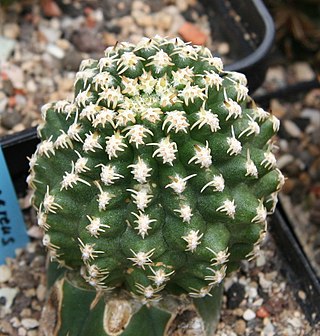Top Qs
Timeline
Chat
Perspective
Pygmaeocereus bieblii
Species of plant From Wikipedia, the free encyclopedia
Remove ads
Pygmaeocereus bieblii, synonym Haageocereus bieblii, is a species of cactus from Peru.[1][2]
Remove ads
Description
Pygmaeocereus bieblii grows individually with spherical, green shoots up to 5 cm (2.0 in) in diameter that barely protrude from the ground. The 10 to 25 barely recognizable ribs are divided into wart-like humps. The single central spine, which is 2 to 4 mm (0.079 to 0.157 in) long and 1 mm (0.039 in) in diameter, may also be missing. The 3 to 10 comb-shaped radial spines are white to dark yellow and 1 to 1.5 mm (0.039 to 0.059 in) long.
The broad, funnel-shaped, white flowers are 6 to 7 cm (2.4 to 2.8 in) long and 4.5 to 6 cm (1.8 to 2.4 in) in diameter. Its flower tube is long and slender. The 6 to 10 mm (0.24 to 0.39 in) long fruits are greenish red to brownish.[3]
Remove ads
Taxonomy
The first description was made in 1995 by Lothar Diers.[4] The specific epithet bieblii honors the German cactus collector Wolfgang Biebl.
Subspecies
As of December 2024[update], Plants of the World Online accepted two subspecies:[1]
- Pygmaeocereus bieblii subsp. bieblii
- Pygmaeocereus bieblii subsp. kuehhasii (Diers) Ostolaza
Distribution
Pygmaeocereus bieblii is distributed in the Ancash region of Peru, northwest of Huaraz, at altitudes of 600 to 1800 meters.
References
External links
Wikiwand - on
Seamless Wikipedia browsing. On steroids.
Remove ads


